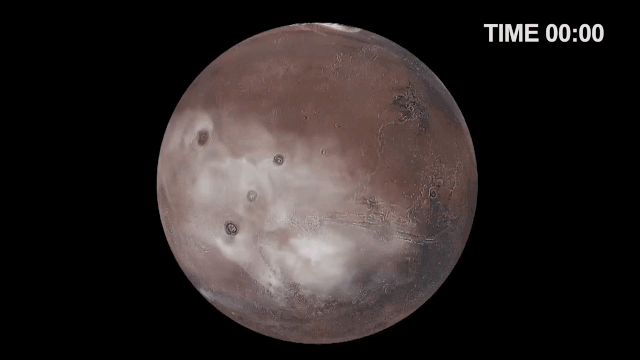Watch Clouds on Mars Drift by in Supercomputer Simulations

Weather models are a daily staple of life on Earth, but they can go interplanetary as well, sometimes with a boost from Earth's most sophisticated computers.
That sort of work is on display in a newly released NASA data visualization showing how clouds grow and shrink over the course of a day on Mars. The visualization is the work of the Mars Climate Modeling Center at NASA's Ames Research Center in California, relying on the institution's supercomputing facility.
In the visualization, features visible on the surface of Mars include the four massive Tharsis volcanic mountains that stand out like knots in a wood plank. The vast Valles Marineris stretches out along the right-hand-side of the view, etched into the Red Planet's surface.
Related: There's a Strange Cloud on Mars Right Now, and It's Just Hanging Around
The visualization is based on data about the Martian northern hemisphere's summer. During that season, equatorial clouds tend to form overnight, then wander away during the day. It's mesmerizing to watch, but modeling efforts like these also help researchers better understand the climate of the Red Planet.
The clouds themselves consist of water ice, like terrestrial clouds, but are typically thinner. By studying visualizations like this, scientists have concluded that Martian clouds shape wind intensity and in turn the water cycle, according to a NASA statement.
- 950-Mile-Long Cloud Spotted Over Martian Volcano. And It Has Staying Power.
- Meteor 'Smoke' May Spawn Cotton Candy Clouds on Mars
- Watch the Clouds on Mars Glide by in This Curiosity Rover Video
Email Meghan Bartels at mbartels@space.com or follow her @meghanbartels. Follow us on Twitter @Spacedotcom and on Facebook.
Get the Space.com Newsletter
Breaking space news, the latest updates on rocket launches, skywatching events and more!

Join our Space Forums to keep talking space on the latest missions, night sky and more! And if you have a news tip, correction or comment, let us know at: community@space.com.

Meghan is a senior writer at Space.com and has more than five years' experience as a science journalist based in New York City. She joined Space.com in July 2018, with previous writing published in outlets including Newsweek and Audubon. Meghan earned an MA in science journalism from New York University and a BA in classics from Georgetown University, and in her free time she enjoys reading and visiting museums. Follow her on Twitter at @meghanbartels.
-
rod ReplyAdmin said:Weather models are a daily staple of life on Earth, but they can go interplanetary as well, sometimes with a boost from Earth's most sophisticated computers.
Watch Clouds on Mars Drift by in Supercomputer Simulations : Read more
Enjoyable views of the Martian clouds here :) Rarely I have observed clouds on Mars but sometimes do with my telescopes using planetary filters. Last year during Mars opposition in July 2018, many amateurs using their telescopes reported the dust storm - I did too, yellowish or pumpkin color Mars. In October 2020, we have another opportunity to view Mars closer up during opposition time. I am looking forward to this. In 2018, Mars angular size 24" in telescope view - very good size. Next year, Mars angular size about 22" so a bit farther from Earth but still should provide some excellent telescope observations. Go get Mars space.com :)









